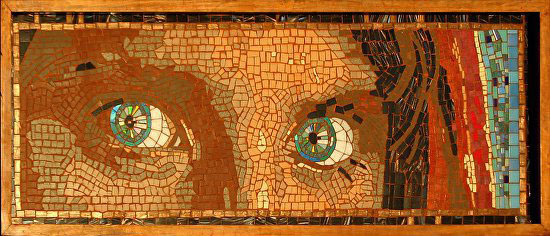Artist Frederic Lecut’s Opus Pixellatum Technique is a tool for rapidly creating original photorealistic mosaics and incorporating improvised elements.
Artist Frederic Lecut
Mosaic Artist Frederic Lecut creates striking portraits of people’s eyes, mosaics that are photorealistic in execution and powerful as compositions because they are cropped closely and look almost like eyes seen in a Niqab.

A Master of Mosaic Art
Note one very important point about Lecut’s Afgan Girl mosaic: It is not merely a faithful depiction of the famous National Geographic photograph, which would have been a satisfying accomplishment in itself, but there is also sophisticated improvisation with larger tesserae and andamento in the mode of opus tesselatum.
In plain English, what I’m saying is that the tiles aren’t just generic elements in a grid but have arrangement and pattern in addition to the overall image being rendered. There is some Art (with a capital A) in that mosaic, specifically that type of improvisation that makes mosaic so damned interesting.
If you still don’t know what I mean, then look at the red rows that make up the girl’s hood and the rows of gold, green, and blue that parallel that. That part of the mosaic looks like something out of a Klimt painting and would be an interesting work of art by itself.
Opus Pixellatum
In 2015, Lecut was looking for a quick method to build huge portraits of the eyes of Yezidi refugees and created a technique using spreadsheets to generate a pixelated patterns from photographs. Lecut calls his technique Opus Pixellatum, but it is much more than a “paint-by-numbers” system, at least how he is using it and teaching people to use it.
Frederic’s “Aha” Moment
Frederic’s method involves creating a gridded pattern with a number in each cell that represents the color to be used, and overlaying that pattern with clear contact paper, sticky side up and pressing the tiles onto the contact paper.
That is predictable enough, but Lecut’s key insight into how this method might be used to create real Art is that you don’t have to press every tile onto the pattern before your eye can render the image. Press on every other tile, step back and see the image as a whole, and then start improvising on what you have.
Frederic has written a blog article that discusses using Opus Pixellatum as starting point for improvising color substitutions and elements of opus tessellatum.
A Class With Frederic Lecut
In late March 2017, Mosaic Art Supply would like to host on a class with Frederic Lecut in which students will use his Opus Pixellatum technique to create a small mosaic portrait of their own eyes from a photograph. We will be sending out a newsletter this week with details and writing a blog article about the class to be offered.


Leave a Reply